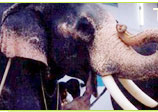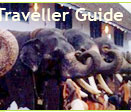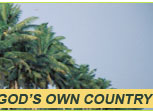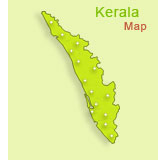





|
||
| Distict | ||
+ Thiruvananthapuram + Kollam + Pathanamthitta + Alappuzha + Kottayam + Idukki + Ernakulam + Thrissur + Palakkad + Malappuram + Kozhikode + Wayanad + Kannur + Kasargod |
||
| Travel Information | ||
+ Where To Dine |
||
| Prime Attractions | ||
| + Adventure in Kerala + Places of Worship + Kerala House Boats +Kerala Architecturall + Picnic Sport + Museum + Amusment Park + Dams + Tea Estate |
||
| Home> | ||||||||||||||||||||||||||||||||||||||||||||||||||||||||||||
|
||||||||||||||||||||||||||||||||||||||||||||||||||||||||||||
| :: Kerala at a Glance | ||||||||||||||||||||||||||||||||||||||||||||||||||||||||||||
|
||||||||||||||||||||||||||||||||||||||||||||||||||||||||||||
| :: Origin of name | ||||||||||||||||||||||||||||||||||||||||||||||||||||||||||||
The origin of the name Kerala is often disputed. The theory most often advanced is that it comes from "kera" (coconut tree) and "Alam" (land or location). Keralites, the occupants of Kerala, refer to the place as Keralam. Possibly, the name comes from chera alam (the land of the cheras) or cher alam (a swamp) (land reclaimed from the sea). |
||||||||||||||||||||||||||||||||||||||||||||||||||||||||||||
| :: About Kerala Tourism | ||||||||||||||||||||||||||||||||||||||||||||||||||||||||||||
Kerala is a popular tourist destination for both domestic and foreign travellers. Among the tourist attractions are great beaches (Kovalam, Cherai and Varkala), serene hill stations (Ponmudi and Munnar), wildlife sanctuaries (Periyar and Eravikulam) and beautiful Kerala Backwaters (Alleppey, Kumarakom, and Punnamada), as also the marvel of kerala building art revealed through Padmanabhapuram Palace, Padmanabhapuram. The tourism department of the state calls the state as God's Own Country. National Geographic Society described Kerala as one of the 50 must-see destinations of a lifetime. Kochi, the commercial capital of the state is known as the Queen of the Arabian Sea. Alapuzha, the first planned town in Kerala is called the "Venice of the East". Tourism plays an important role in the state's economy. |
||||||||||||||||||||||||||||||||||||||||||||||||||||||||||||
| :: History of Kerala | ||||||||||||||||||||||||||||||||||||||||||||||||||||||||||||
According to local mythology the land of Kerala was created by Parusurama the avatar of Mahavishnu who claimed the land by throwing his axe into the ocean. People have lived in the region now known as Kerala since ancient times. The Sanskrit epic Aitareya Aranyaka has the earliest specific mention of Kerala. Katyayana (4th century BC) and Patanjali (2nd century BC) show their acquaintance with the geography of Kerala. Pliny the Elder mentions Muziris (modern Kodungallur) as the first port in India (N.H. 6.26); slightly later in time, the unknown author of the Periplus of the Erythraean Sea notes that "both Muziris and Nelkunda (modern Kottayam) are now busy places". The emergence of the Malayalam language from Tamil sheds light on the ancient past of Kerala. Malayalam (Mala or Mountain + Alam or location) means the 'living/inhabitants in mountain' in Tamil (Malayalam, which earlier implied the geographical location of the region, was replaced by 'Kerala' and now identifies the language spoken in the region). At first, the area was simply another Tamil-speaking region, however, it became linguistically separate from the Tamil region in the early 14th century. The Chera empire ruled the area of Kerala from ancient times with Tamil as their court language. Allied with the Pallavas, they were continually at war with the neighbouring kingdoms of the Cholas and Pandyas. The Chera capital was Vanchi, whose exact location is still a matter of conjecture. A regional identity distinct from the Tamils developed in 8th-14th centuries, with the second Chera empire and with the development of the Malayalam language. Both Buddhism and Jainism reached Kerala at an early period. Like other parts of ancient India, Buddhism and Jainism co-existed with early Shaivite beliefs and faiths associated with tribal life during the first five centuries. It was only after the "Sangam" Period that large groups of Northern Brahmins started migrating to Kerala, possibly during Kalabhra, Rashtrakuta, Chalukya, Pallava and Hoysala invasions. By the 8th and 9th centuries, 2nd Chera kings inclined to Vaishnavism and some of them wrote great literary works in the stream of Vishnu Bhakthi. When all over India Hinduism was revived by intellectuals like Shankara and by Bhakti movements, and finally Buddhism and Jainism merged into their mother religion. Jewish settlers avoiding persecution in their homeland migrated to Kerala in the early centuries. Arab merchants founded Kerala's early Muslim community, the Mappilas, in the 8th century. According to some the history of Christianity in Kerala dates back to the arrival of St. Thomas the Apostle at Kodungallur in A.D. 52. For a long time this was disputed. However in 2002 The British researcher, William Dalrymple travelled across the Arabian Sea to Kerala in a boat similar to those mentioned in ancient Jewish and Roman texts and showed how the Nasrani-Jewish people had travelled to Kodungalloor. He followed the same course as mentioned in the Acts of Thomas, a copy of which survives in a monastery on Mount Sinai. A Christian-Jewish community was later established by a contingent of Jewish Nasranis led by Knai Thoma who arrived in 345. Cheraman Perumal, the then king of Malabar issued a proclamation giving land and privileges to the Knanaya Yehudeya-Nasranis on copper plates on a Saturday in March (Kumbham 29), 345. This was followed by another round of migration recorded in the Tharisappally records from around the 8th century. When the Portuguese arrived in the early 1500s, they tried to impose Roman Catholicism on the Nasrani people. The Nasranis (also called Syrian Christians of Kerala) resisted the conversion attempts of the Portuguese to bring them under the Pope, and instead established an independent Church. Vasco da Gama's voyage to Kerala from Portugal in 1498 was largely motivated by Portuguese determination to break the Arabs' control over the trade between local spice producers and the Middle East, which existed even before Islam originated. He established India's first Portuguese fortress at Cochin (Kochi) in 1503 and from there, taking advantage of the rivalry existing between the royal families of Calicut and Cochin, managed to destroy the monopoly. The dispute between Calicut and Cochin, however, provided an opportunity for the Dutch to come in and finally expel the Portuguese from their forts. The Dutch would, in turn, be routed by the Travancore (Thiruvithamcoore) ruler Marthanda Varma at the Battle of Kulachal in 1741. The British moved into the area in the form of the British East India Company and were firmly established in Kerala by the beginning of the seventeenth century. Tipu Sultan attempted to encroach on British-held territory in 1792, but was defeated and the British remained in control until independence. Organised expressions of discontent with British rule were relatively infrequent in Kerala. Uprisings of note include the rebellion by Pazhassi Raja, Veluthampi Dalawa, and the Punnapra-Vayalar revolt of 1946. Mass protests were mainly directed at established social evils such as untouchability and unapproachability. The non-violent and largely peaceful Vaikom Satyagraha of 1924 was instrumental in securing entry to the public roads adjacent to the Vaikom temple for people belonging to backward castes. In 1936, Sree Chithira Thirunal Balaramavarma Maharaja, ruler of Travancore issued the Temple Entry Proclamation, declaring the temples of his kingdom open to all worshippers, irrespective of caste. Modern Kerala was created in 1956 when Malabar, which had been part of the Madras Presidency, was merged with Travancore and Kochi. The latter two were princely states, distinguished in that they had concerned themselves with the education and provision of basic services to the residents of their territories. First assembly elections in Kerala took place in 1957 and the first elected communist government of asia came into power headed by E.M.S.Namboothirippadu. The radical reforms introduced by that government in favour of toiling people changed the social order which prevailed in kerala for centuries to a great extent. |
||||||||||||||||||||||||||||||||||||||||||||||||||||||||||||
| top^ | ||||||||||||||||||||||||||||||||||||||||||||||||||||||||||||
| :: Capital of Kerala | ||||||||||||||||||||||||||||||||||||||||||||||||||||||||||||
Thiruvananthapuram formerly known as Trivandrum, is the capital of Kerala. It is located on the west coast of India near the extreme south of the mainland. The city is characterized by its undulating terrain of low coastal hills with narrow winding lanes and busy commercial alleys. With a population of 889,191 (as of 2001) it is the biggest city in Kerala. The city, being the state capital houses many government offices, organizations and companies. Apart from being the political nerve center of Kerala, it is also a major academic hub and houses several premier educational institutions including the Kerala University. Thiruvananthapuram is also home to many science and technology institutions, the most prominent being the Vikram Sarabhai Space Centre (VSSC). |
||||||||||||||||||||||||||||||||||||||||||||||||||||||||||||
| :: Geography | ||||||||||||||||||||||||||||||||||||||||||||||||||||||||||||
Kerala is bounded by the Arabian Sea on the west and the Western Ghats on the east. The states of Karnataka in the north and Tamil Nadu in the east are Kerala's immediate neighbours. Mahe, a part of the union territory of Pondicherry, is an enclave within Kerala. Geographically Kerala is divided into three regions: > Highland or Mountain region > Midland or the rolling hills > Lowland or the coastal plain land There are 44 rivers flowing through Kerala, most of them are small and entirely fed by the Monsoons. The Kerala Backwaters, an interconnected system of brackish water lakes and river estuaries, lies behind the coast and runs virtually the length of the state. |
||||||||||||||||||||||||||||||||||||||||||||||||||||||||||||
| :: Demographics | ||||||||||||||||||||||||||||||||||||||||||||||||||||||||||||
Malayalam is the official language of Kerala. A large number of Tamil speaking people are present in the state, perhaps the biggest Tamil population outside Tamil Nadu. The major religions followed[1] in Kerala are Hinduism (56.1%), Islam (24.7%), and Christianity (19%). Kerala also had a tiny Jewish population till recently, said to date from 587 BC when they fled the occupation of Jerusalem by Nebuchadnezzar. The state has many famous temples, churches, and mosques. The synagogue in Kochi is the oldest in the British Commonwealth. |
||||||||||||||||||||||||||||||||||||||||||||||||||||||||||||
| :: Culture of Kerala | ||||||||||||||||||||||||||||||||||||||||||||||||||||||||||||
Among the people who have enriched Indian Cultural Heritage and helped the cause of national integration, the people of the Kerala region of South India have a place of honour. Kerala culture is in fact, an integral part of Indian culture. Kerala like the Indian sub continent can claim to have a culture the history of which runs into the dim recesses of antiquity. |
||||||||||||||||||||||||||||||||||||||||||||||||||||||||||||
| :: Economy | ||||||||||||||||||||||||||||||||||||||||||||||||||||||||||||
The economy of Kerala is predominantly agrarian in nature. In terms of per capita income and production Kerala lags behind many Indian States, but in terms of Human Development Index and the standard of living of the people, Kerala is much ahead of most other states in India. In fact, in certain development indices Kerala is on a par with some of the developed countries. This peculiar paradox often termed as the "Kerala Phenomenon" or Kerala model of development by experts, which is mainly owing to the performance of the state in the service sector. |
||||||||||||||||||||||||||||||||||||||||||||||||||||||||||||
| top^ | ||||||||||||||||||||||||||||||||||||||||||||||||||||||||||||
| :: State formation | ||||||||||||||||||||||||||||||||||||||||||||||||||||||||||||
The modern State of Kerala was formed by the amalgamation of three regions, the Kingdom of Thiruvithamcoore (Travancore), the Kingdom of Kochi (Cochin) and Malabar District. Thiruvithaamcoore and Kochi, former princely states, were merged to form Thiru-Kochi on July 1, 1949. Thiru-Kochi was merged with Malabar District and Kasargod taluk of South Kanara District to form the State of Kerala on November 1, 1956, based on the recommendations of the State Reorganisation Commission set up by the Government of India. |
||||||||||||||||||||||||||||||||||||||||||||||||||||||||||||
| :: Administration | ||||||||||||||||||||||||||||||||||||||||||||||||||||||||||||
Kerala is divided into 14 districts. They are (from north to south) Kasargod, Kannur (Cannanore), Wayanad (Wynad), Kozhikode (Calicut), Malappuram, Palakkad (Palghat), Thrissur (Trichur), Ernakulam (Cochin), Idukki, Alappuzha (Alleppey), Kottayam, Pathanamthitta, Kollam (Quilon) and Thiruvananthapuram (Trivandrum) |
||||||||||||||||||||||||||||||||||||||||||||||||||||||||||||
| :: Politics | ||||||||||||||||||||||||||||||||||||||||||||||||||||||||||||
Kerala gained the distinction, in 1957, of having democratically elected a Communist government, one of few anywhere in the world. Kerala has a reputation as one of the most left-wing states in India. The people of Kerala are very politically aware and are more active participants in the political process than those in the rest of the country. Today the political life of Kerala is dominated by two alliances, the United Democratic Front (led by the Indian National Congress) and the Left Democratic Front (led by CPI(M)). Currently UDF in which the Congress (I) is the largest coalition partner, controls the government. |
||||||||||||||||||||||||||||||||||||||||||||||||||||||||||||
| :: Transport | ||||||||||||||||||||||||||||||||||||||||||||||||||||||||||||
Air : Thiruvananthapuram and Cochin are International Airports and Calicut has international services to several destinations in Gulf. Daily flights are operated from Thiruvananthapuram to Singapore, Colombo, Male, Muscat, Bahrain, Kuwait, Abu Dhabi and Dubai. International airlines operating from Thiruvananthapuram are Gulf Air, Qatar Airways, Singapore Airlines, Air Lanka, Air Maldives and Air India. Cochin, is air-connected with Delhi, Mumbai, Bangalore, Chennai, Mali and Goa. Airports are in the outskirts of the cities. Pre-paid taxi service is available in the airports. |
||||||||||||||||||||||||||||||||||||||||||||||||||||||||||||
| :: Kerala Disticts | ||||||||||||||||||||||||||||||||||||||||||||||||||||||||||||
|
||||||||||||||||||||||||||||||||||||||||||||||||||||||||||||
| top^ |
Copyright © 2004-14 Kerala Tourism All Rights Reserved. Privacy Policy and Terms of Use.

